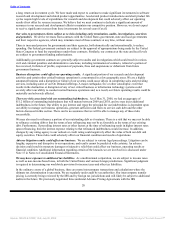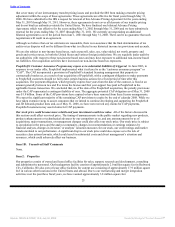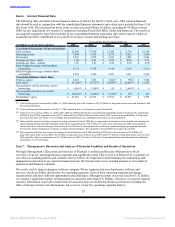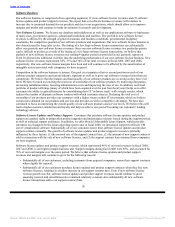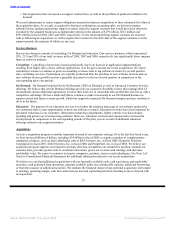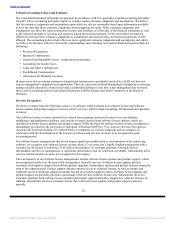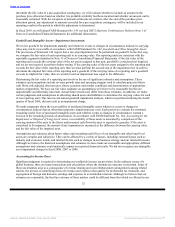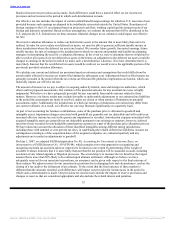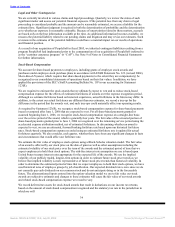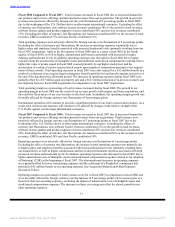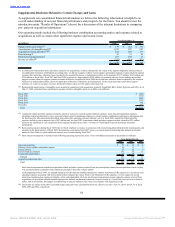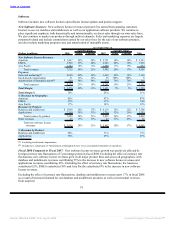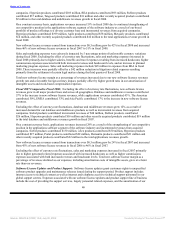Oracle 2007 Annual Report Download - page 35
Download and view the complete annual report
Please find page 35 of the 2007 Oracle annual report below. You can navigate through the pages in the report by either clicking on the pages listed below, or by using the keyword search tool below to find specific information within the annual report.
Table of Contents
elements is determinable. Under the residual method, the fair value of the undelivered elements is deferred
and the remaining portion of the arrangement fee is allocated to the delivered elements and is recognized as
revenue.
Substantially all of our software license arrangements do not include acceptance provisions. However, if
acceptance provisions exist as part of public policy, for example in agreements with government entities when
acceptance periods are required by law, or within previously executed terms and conditions that are
referenced in the current agreement and are short-term in nature, we generally recognize revenues upon
delivery provided the acceptance terms are perfunctory and all other revenue recognition criteria have been
met. If acceptance provisions are not perfunctory (for example, acceptance provisions that are long-term in
nature or are not included as standard terms of an arrangement), revenues are recognized upon the earlier of
receipt of written customer acceptance or expiration of the acceptance period.
We also evaluate arrangements with governmental entities containing “fiscal funding” or “termination for
convenience” provisions, when such provisions are required by law, to determine the probability of possible
cancellation. We consider multiple factors, including the history with the customer in similar transactions, the
“essential use” of the software licenses and the planning, budgeting and approval processes undertaken by the
governmental entity. If we determine upon execution of these arrangements that the likelihood of cancellation
is remote, we then recognize revenues once all of the criteria described above have been met. If such a
determination cannot be made, revenues are recognized upon the earlier of cash receipt or approval of the
applicable funding provision by the governmental entity.
We assess whether fees are fixed or determinable at the time of sale and recognize revenues if all other
revenue recognition requirements are met. Our standard payment terms are net 30 days. However, payment
terms may vary based on the country in which the agreement is executed. Payments that are due within six
months are generally deemed to be fixed or determinable based on our successful collection history on such
arrangements, and thereby satisfy the required criteria for revenue recognition.
While most of our arrangements include short-term payment terms, we have a standard practice of providing
long-term financing to credit worthy customers through our financing division. Since fiscal 1989, when our
financing division was formed, we have established a history of collection, without concessions, on these
receivables with payment terms that generally extend up to five years from the contract date. Provided all
other revenue recognition criteria have been met, we recognize new software license revenues for these
arrangements upon delivery, net of any payment discounts from financing transactions. We have generally
sold receivables financed through our financing division on a non-recourse basis to third party financing
institutions. We account for the sale of these receivables as “true sales” as defined in FASB Statement
No. 140, Accounting for Transfers and Servicing of Financial Assets and Extinguishments of Liabilities.
Our customers include several of our suppliers and on rare occasion, we have purchased goods or services for
our operations from these vendors at or about the same time that we have licensed our software to these same
companies (Concurrent Transaction). Software license agreements that occur within a three-month time
period from the date we have purchased goods or services from that same customer are reviewed for
appropriate accounting treatment and disclosure. When we acquire goods or services from a customer, we
negotiate the purchase separately from any software license transaction, at terms we consider to be at arm’s
length, and settle the purchase in cash. We recognize new software license revenues from Concurrent
Transactions if all of our revenue recognition criteria are met and the goods and services acquired are
necessary for our current operations.
Business Combinations
In accordance with Financial Accounting Standards Board (FASB) Statement No. 141, Business
Combinations, we allocate the purchase price of acquired companies to the tangible and intangible assets
acquired and liabilities assumed as well as to in-process research and development based upon their estimated
fair values at the acquisition date. The purchase price allocation process requires management to make
significant estimates and assumptions, especially at acquisition date with respect to intangible assets, support
obligations assumed, estimated restructuring liabilities and pre-acquisition contingencies.
30
Source: ORACLE CORP, 10-K, July 02, 2008 Powered by Morningstar® Document Research℠


